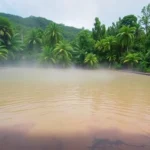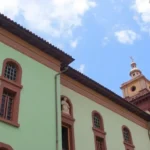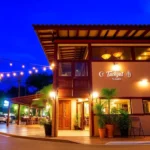Travel Guide to San Andres Island Colombia: Things to See and Do
- A glimpse into the history of San Andrés
- How to reach San Andrés
- Entry fee to San Andrés
- Getting around San Andrés
- Where to stay in San Andrés
- The best things to see and do in San Andrés
- Beaches of San Andrés
- Excursions to consider in San Andrés
- Where to eat in San Andrés
- Travel recommendations for San Andrés
- Interactive map of attractions in San Andrés
The island of San Andrés is a Caribbean paradise that offers a unique blend of natural beauty, vibrant culture, and rich history. If you're looking to elevate your Colombian adventure, this guide delves into everything you need to know about what to see and do in San Andrés. From practical travel tips to unforgettable excursions and dining options, we’ve got you covered for an extraordinary experience in this tropical haven.
Despite its remote location — sitting approximately 800 km from Colombia's northern coast and much closer to Nicaragua — visiting San Andrés is a must. With its stunning landscapes, vibrant beaches, and the enchanting "Sea of Seven Colors," the island promises a memorable escape filled with warm traditions and delicious cuisine. Now, let's dive into the complete travel guide to San Andrés Island, packed with essential tips and insights to plan your trip effectively.
A glimpse into the history of San Andrés
The history of San Andrés and its neighboring island, Providencia, is fascinating and complex. Initially uninhabited, these islands were claimed by Christopher Columbus and the Spanish in 1502. However, they remained largely deserted until European settlers from England and Holland established settlements more than a century later. During this period, they had a notorious neighbor: the infamous Pirate Morgan, who used the islands to hide his plundered treasures.
Control of the islands eventually reverted back to the Spanish crown until Colombia gained independence. The islands were liberated in large part by French corsair Luis Aury, who turned them over to Simón Bolívar's forces. San Andrés and Providencia officially became part of Colombia in 1822 and 1823, making this region the only Colombian department composed entirely of islands. In recent decades, Nicaragua has made claims to the islands, but none have been successful.
The true essence of these islands lies in their indigenous inhabitants, known as the raizales. This community, of African descent, has retained a unique culture distinct from the mainland. They predominantly practice Baptist Christianity, celebrate distinct traditions, and even speak a creole language known as San Andrés Creole, a fascinating blend of English, African languages, and Spanish. If you encounter a local who speaks it, take a moment to appreciate this linguistic gem!
How to reach San Andrés
Getting to San Andrés is quite straightforward, despite being a remote destination. The island sits about 800 km from the northern coast of Colombia and is significantly closer to Nicaragua, at just 220 km. Therefore, the only practical way to reach it is by airplane. Numerous airlines, including Latam, Avianca, and Viva Colombia, offer direct flights from several Colombian cities like Medellín, Cartagena, and Bogotá, with ticket prices typically hovering around €50.
For instance, we traveled from Medellín with Viva Colombia for €43 and returned to Cartagena with Latam for €39. Both flights were booked through Skyscanner about six weeks in advance.
Upon arrival at the airport, you can either take a taxi or walk to your accommodation, depending on its location. We opted to walk since we stayed in the heart of San Andrés.
If you plan to visit Providencia, it’s best to take a direct flight from San Andrés, as boat travel can be quite rough for those sensitive to waves.
Entry fee to San Andrés
Upon entering the islands, tourists are required to pay an entry fee of 117,000 COP (as of 2021). This tourism tax is supposedly allocated for infrastructure improvements and social projects on the island. However, after discussions with other travelers and locals, we felt that not much of the collected funds reach their intended purposes.
You can pay this fee at the airport during departure, and it’s advisable to have cash on hand. We settled our payment at the airline check-in counter.
Getting around San Andrés
San Andrés features a scenic coastal road that encircles the island, spanning roughly 15 km, along with several interior roads leading to local towns such as La Loma. There are various ways to navigate the island:
- Bicycle rental: A local recommended renting electric bikes for an affordable price (30,000 COP per day or 5,000 COP per hour) from Jorge (Phone: 3186491194).
- Motorbike rental: This was our choice for a day of exploration. Prices start at around 60,000 COP for the day, with some rental shops quoting up to 70,000 COP. We rented from a guy with a website and got a fixed price of 60,000 COP.
- Golf carts, mules, or buggies: Ideal for those looking for comfort. Golf carts start at 120,000 COP, while mules (which allow for more speed) start at approximately 150,000 COP. Rental shops are scattered throughout the main town.
- Tourist bus: An excellent option for those who prefer not to drive; it makes stops at major attractions for around 35,000 COP.
- Local buses: These connect populated areas and major sights, costing about 2,800 COP per ride.
- Taxis: While available, they tend to be the most expensive mode of transport.
Where to stay in San Andrés
Accommodation options are abundant across the island, but the town center is the most convenient place to stay. This bustling area offers a plethora of affordable lodging, restaurants, shops, and services. Aim for a hotel located from Calle 4 north toward Spratt Bight Beach, as this proximity makes it easier to access boat trips for excursions.
Here are some recommended places to stay:
- Alojamientos Neca (town)
- Aqualina Inn (town)
- Hostal Posada San Martín (town)
- Apartahotel Plaza (town)
- Haynes Cay View (near Haynes Cay)
- República Hostel San Andrés (near La Piscinita)
Don't forget to get travel insurance from IATI with a 5% discount here to cover any unexpected issues.
The best things to see and do in San Andrés
San Andrés offers a variety of attractions that cater to all interests. You’ll know you’re approaching a popular spot when you see multiple motorcycles parked nearby. We rented a motorbike to explore, but you can also opt for the tourist buses that connect these sites. If you’re interested in the bus option, you can reserve your spot online.
Here are some must-visit attractions in San Andrés:
Rocky Cay
This small islet connects to the beach through a series of buoys tied together. We enjoyed the beach but didn’t make it to the island. It’s easy to wade through the shallow waters for the roughly 200 meters, and you can hold onto the rope for support.
Casa Museo Isleña
This museum features a traditional house from the 1800s, the era of colonization. They offer guided tours that share local history and conclude with a dance where you can learn traditional island music steps. Entrance fee: 10,000 COP.
Cueva de Morgan
Legend has it that the infamous pirate Henry Morgan used this cave to hide treasures he plundered from Spanish galleons. Today, it's a themed park with exhibitions and dance shows, but the treasure is truly the entry fee of 15,000 COP. We decided to skip it based on recommendations from fellow travelers.
West View and La Piscinita
These two spots offer crystal-clear waters ideal for snorkeling. They aren’t traditional beaches but rather pools near rocks, accessible through beach clubs that charge an entrance fee (around 5,000 COP).
Hoyo Soplador
This natural phenomenon occurs when water currents crash against rocks, creating a geyser-like effect. It might not be as impressive as it sounds, but the surrounding atmosphere is lively. Entrance fee: 5,000 COP.
Laguna Big Pond
Located in the heart of the island, this small lagoon is surrounded by lush nature and can be easily circumnavigated on foot. We passed by but opted not to stop due to the entrance fee of 5,000 COP.
Mirador de La Loma
La Loma is the island’s highest populated area, making it the perfect spot for panoramic views. The lookout itself is just a makeshift terrace, but the 2,000 COP fee is worth it for the stunning vistas.
Primera Iglesia Bautista
This is the first Baptist church built not only on the island but in all of Latin America, dating back to 1847. Made of wood, it’s quite charming. Visitors can climb the bell tower for a spectacular view of the island. Entrance fee: 10,000 COP.
Sendero a los manglares de Old Point Regional Park
This wooden boardwalk leads through mangrove areas. You’ll need to park your bike at the entrance and pay to access the path. Although we didn’t visit, it sounds intriguing.
Remains of shipwrecks
If you keep your eyes peeled, you’ll spot the remains of various ships along the coast of the island. One of the most interesting wrecks is on the eastern side of San Andrés, at the end of the boardwalk.
Statues of historical significance
These statues, representing key figures from the island's history, are found scattered throughout San Andrés. One intriguing location is a property next to Cueva de Morgan, featuring vibrant wooden houses alongside the statues.
Beaches of San Andrés
San Andrés boasts several stunning beaches where you can unwind and enjoy refreshing swims. The eastern coast offers sandy shores ideal for swimming, while the western coast is more rocky but features excellent snorkeling spots. Here are some of our favorites:
Spratt Bight
This is the main beach in San Andrés and the most crowded. While it’s expansive enough to find a spot, we found the eastern side to be the most picturesque. It’s an urban beach with a lively promenade. When we visited, it was somewhat algae-ridden.
Cocoplum Bay
This beach connects with Rocky Cay and is less crowded than Spratt Bight. The water is clearer here, making it more appealing. We parked our motorbike for free near Club Aqua and accessed the beach without any fees.
Sound Bay
Located a bit further south, this beach has stronger currents and more rocks, but it’s still suitable for swimming. Additionally, it features Donde Francesca, one of the island's most renowned (and pricier) restaurants.
El Salto de Morgan, West View, and La Piscinita
These spots on the western coast are designed for snorkeling and rock jumping. While they host bars, lounges, and music, we chose not to linger. Entry costs around 5,000 COP.
Excursions to consider in San Andrés
Set aside at least one day for excursions to nearby attractions that are well worth the visit. You’ll find numerous agencies and locals offering tours. If you’d like to book in advance, you can do so here. The main points of interest include:
Johnny Cay, the top excursion in San Andrés
This small, perfectly round island is adorned with palm trees and white sandy beaches surrounded by crystal-clear water. However, it has a rocky area with dead coral, and the limited swimming space can get crowded with boats and visitors. There are a few restaurants and bars on the island, but prices are steep, with meals averaging around 15,000 COP, and luxurious options like lobster available.
Boat tours to Johnny Cay are affordable 🙂. You can book your tour or find more info there. Be prepared for an 8,000 COP entrance fee. It’s worth taking some time to explore the island and observe the sunbathing iguanas. If relaxing isn’t your thing, there's a pleasant grassy area in the center to rest, read, or take a nap.
The Aquarium
This smaller islet features a sandbar teeming with colorful fish, eager for food brought by tourists. It’s the go-to spot for snorkeling and swimming. It’s located next to Haynes Cay (where you arrive by boat) and another small sandy island to the north, which is walkable.
You can rent snorkeling gear or a locker for 10,000 COP each, but we found it manageable to keep our belongings on the beach without issues. While the scenery is beautiful (despite the crowds), we were uncomfortable when staff started calling out for tourists to take photos with the local manta rays for a fee. This kind of interaction with wildlife is disconcerting.
Mangroves
Located in the Old Point area, this region is filled with mangroves, and visiting is highly recommended, though it’s often included in packages that also cover the next point.
Swimming with manta rays or visiting a starfish area (CAUTION!)
These are areas where these marine animals are found. We chose not to visit these spots, fully aware that interacting with them could lead to frustration and discomfort with irresponsible tourism practices.
Most tours generally include only transport (though some VIP options may include lunch and other perks) and are relatively inexpensive. Prices vary based on the itinerary. For example, our tour to Johnny Cay and The Aquarium cost 30,000 COP per person (including the 8,000 COP entrance fee). We departed at 9:30, spent about an hour and a half at The Aquarium, and then headed to Johnny Cay, where you can select to return at 1:00, 3:00, or 3:30.
If you want to reserve your tour in advance, check out this link.
For those interested in visiting all four sites, the most popular tour costs around 50,000 COP.
Excursions typically depart between 8:30 and 9:30 AM from either the Portofino dock or the main beach in San Andrés. You’ll notice many vendors offering tours in the morning, and we booked ours the day before at the Coonative Brothers office located on the main beach.
Alternatively, you can opt to visit different spots on separate days, like Johnny Cay one day and The Aquarium another. Round-trip costs for each location typically range from 20,000 to 25,000 COP.
Online reservations for excursions are available here:
→ Catamaran tour of San Andrés bay
Where to eat in San Andrés
San Andrés offers an array of dining options, allowing you to enjoy delicious meals without always breaking the bank. However, as an island, prices tend to be higher than on the mainland. Here are our top recommendations:
- Donde Francesca: This might be the priciest meal we had on the trip, but it was worth it. It’s simply a beachside shack with quirky decor (think fish hanging from the ceiling and animal heads on the walls). The terrace offers splendid ocean views. Prices range from 40,000 to 50,000 COP. We enjoyed a seafood casserole and pulpo with three sauces, and the casserole was the highlight. If you’re visiting during peak season, make a reservation to secure a spot outside.
- La Fondita: A budget-friendly restaurant offering combo plates starting at around 15,000 COP.
- La Calle del Rojo: A local spot bustling with activity throughout the day. Lunch options include meat or fish dishes, complete with soup, rice, and plantains for about 15,000-18,000 COP. It’s a no-frills establishment with simple outdoor seating, but the food is tasty and affordable.
- Comidas Rápidas Mora: A street vendor serving skewers of meat with a side of arepas or roasted plantains (8,000 COP). We tried the mixed meat skewer and enjoyed it while strolling along the promenade, complemented by fresh juice from a local chain, Cosechas.
- Restaurante Sol y Sombra: Offers a full lunch (soup, juice, and main dish) for just 11,000 COP, located on 20 de Julio Avenue, close to the beach. It’s a small, clean restaurant with delicious, hearty meals.
- Homemade food stalls: Along the eastern end of the promenade, you’ll find local women selling freshly cooked meals from their homes. These stalls are open from midday until the evening, so it’s best to visit when they first set up to enjoy the freshest offerings.
For further details, check out our article on five restaurants to enjoy good and affordable food in San Andrés.
Travel recommendations for San Andrés
There’s a visitor information center on the main beach that’s helpful for picking up maps and jotting down interesting sites, though they’re not particularly informative about tour options.
The island boasts all kinds of services for travelers: ATMs, shops, supermarkets, and restaurants for every budget, along with WiFi (albeit slow), and Juan Valdez coffee shops.
For essential items like water, the most affordable supermarkets are Super Todo and Super Éxito. If you need sunscreen, avoid purchasing it at pharmacies, as it’s significantly cheaper at supermarkets or beachside shops.
As a duty-free zone, San Andrés offers tax-free products, which is particularly beneficial for items like alcohol and tobacco. There are also numerous shops selling clothing, cosmetics, and other goods, but we didn’t delve into those as they’re not our primary focus.
Interactive map of attractions in San Andrés
We’ve included an interactive map highlighting the key points of interest discussed throughout this article.
While we encountered a few disappointments, we have to admit that our time in San Andrés was nothing short of a delightful experience. The Caribbean truly offers a magical allure! Our stay lasted four days, which we believe is an ideal duration. Although we may not return to San Andrés soon (though, never say never), we are eager to explore Providencia, which is more tranquil and less touristy.
We hope this travel guide to San Andrés Island has equipped you with all the necessary information regarding what to see and do, helping you plan your trip with confidence while enjoying this Colombian gem.
Stay updated on our journey through Colombia by following our Instagram stories.
| Save on your trip |
| Compare and find cheap flights here |
| Find accommodation at the best prices here |
| Book activities and excursions in Spanish here |
| Get a 5% discount on your IATI travel insurance here |
| Reserve airport transfers here |
| Learn how to withdraw money without fees here |
| Get a 5% discount on your Holafly eSIM here |
| Rent a car with the best deals here |
| Compare prices for van rentals here |
| The best books and travel guides here |
| All of our articles about Colombia |





Deja una respuesta